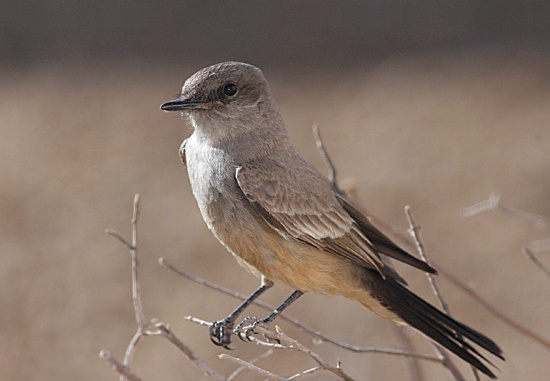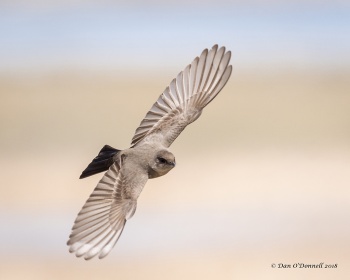Nutcracker (talk | contribs) (more details) |
(→External Links: gsearch check template added) |
||
| (8 intermediate revisions by 2 users not shown) | |||
| Line 1: | Line 1: | ||
| − | [[Image:39270Say s Phoebe April 4 07.jpg|thumb|550px|right|Photo by {{user|Leslie|Leslie}}<br />Hereford, [[Arizona]], [[USA]]]] | + | [[Image:39270Say s Phoebe April 4 07.jpg|thumb|550px|right|Photo © by {{user|Leslie|Leslie}}<br />Hereford, [[Arizona]], [[USA]], 4 April 2007]] |
;[[:Category:Sayornis|Sayornis]] saya | ;[[:Category:Sayornis|Sayornis]] saya | ||
==Identification== | ==Identification== | ||
| − | + | ||
| − | A medium-small grayish bird with distinctive rich rufous underparts and pale gray wing bars; dark eyestripe. | + | Length 17–19·5 cm (6¾-7¾ in), weight 21 g<br /> |
| + | A medium-small grayish bird with distinctive rich rufous underparts and pale gray wing bars; dark eyestripe. Black tail. <br /> | ||
| + | Sexes similar; juvenile differs in orangey-buff wingbars. | ||
====Similar Species==== | ====Similar Species==== | ||
| − | Female [[Vermilion Flycatcher]] is superficially similar, but differs in smaller size, shorter tail, streaked breast, and weak whitish supercilium. | + | Female [[Vermilion Flycatcher]] is superficially similar, but differs in smaller size, shorter tail, streaked breast, and weak whitish [[Topography#Heads|supercilium]]. |
| + | [[Image:DJO20180423B.JPG|thumb|350px|right|Subspecies ''S. s. saya''<br />Photo © by {{user|DJ+ODonnell|DJ ODonnell}}<br />Loveland, Larimer Co., [[Colorado]], 23 April 2018]] | ||
==Distribution== | ==Distribution== | ||
| − | Western [[U.S.]] except for coastal areas in summer; moves south to along coasts and along U.S.-[[Mexico|Mexican]] border for winter, range extends southward into | + | Western [[U.S.]] except for coastal areas in summer; moves south to along coasts and along U.S.-[[Mexico|Mexican]] border for winter, range extends southward into Mexico. |
==Taxonomy== | ==Taxonomy== | ||
====Subspecies==== | ====Subspecies==== | ||
There are 2 subspecies<sup>[[#References|[1]]]</sup>: | There are 2 subspecies<sup>[[#References|[1]]]</sup>: | ||
| − | *''S. s. saya'': | + | *''S. s. saya'': Darker, smaller bill. |
:*[[North America]] ([[Alaska]] to southern [[Mexico]]) | :*[[North America]] ([[Alaska]] to southern [[Mexico]]) | ||
| − | *''S. s. quiescens'': | + | *''S. s. quiescens'': Paler, larger bill. |
:*Northern half of [[Baja California]] and Isla de Cedros | :*Northern half of [[Baja California]] and Isla de Cedros | ||
| + | |||
==Habitat== | ==Habitat== | ||
Open country: prairie, desert, fields, arid scrub. | Open country: prairie, desert, fields, arid scrub. | ||
==Behaviour== | ==Behaviour== | ||
| + | They pump their tail down and up. | ||
====Diet==== | ====Diet==== | ||
Their main diet consists of arthropods, with some bees, flies, wasps and fruit also consumed. | Their main diet consists of arthropods, with some bees, flies, wasps and fruit also consumed. | ||
| + | ====Breeding==== | ||
| + | Mid-April to early August in much of USA and Canada and March to September in Mexico; often double-brooded. Hovering nest-site-showing display by male with wings fluttering in shallow arc while repeating chatter vocalizations. Mud nest requires sheltered ledge. Clutch usually of 4–5 white eggs. | ||
| + | ====Vocalisations==== | ||
| + | Distinctive call is a mournful descending whistle often described as melancholy call and despondent. | ||
| + | |||
==References== | ==References== | ||
| − | #{{Ref- | + | #{{Ref-Clements6thAug18}}#Farnsworth, A. & Lebbin, D. (2018). Say's Phoebe (''Sayornis saya''). In: del Hoyo, J., Elliott, A., Sargatal, J., Christie, D.A. & de Juana, E. (eds.). Handbook of the Birds of the World Alive. Lynx Edicions, Barcelona. (retrieved from https://www.hbw.com/node/57382 on 6 December 2018). |
| + | #Schukman, J. M. and B. O. Wolf (1998). Say's Phoebe (''Sayornis saya''), version 2.0. In The Birds of North America (A. F. Poole and F. B. Gill, Editors). Cornell Lab of Ornithology, Ithaca, NY, USA. https://doi.org/10.2173/bna.374 | ||
{{ref}} | {{ref}} | ||
| + | |||
==External Links== | ==External Links== | ||
| − | {{GSearch| | + | {{GSearch|sayornis+saya}} |
| + | {{GS-checked}} | ||
| + | <br /> | ||
<br /> | <br /> | ||
| − | |||
| − | [[Category:Birds]][[Category:Sayornis | + | [[Category:Birds]][[Category:Sayornis]] |
Latest revision as of 20:44, 28 November 2021
- Sayornis saya
Identification
Length 17–19·5 cm (6¾-7¾ in), weight 21 g
A medium-small grayish bird with distinctive rich rufous underparts and pale gray wing bars; dark eyestripe. Black tail.
Sexes similar; juvenile differs in orangey-buff wingbars.
Similar Species
Female Vermilion Flycatcher is superficially similar, but differs in smaller size, shorter tail, streaked breast, and weak whitish supercilium.
Distribution
Western U.S. except for coastal areas in summer; moves south to along coasts and along U.S.-Mexican border for winter, range extends southward into Mexico.
Taxonomy
Subspecies
There are 2 subspecies[1]:
- S. s. saya: Darker, smaller bill.
- North America (Alaska to southern Mexico)
- S. s. quiescens: Paler, larger bill.
- Northern half of Baja California and Isla de Cedros
Habitat
Open country: prairie, desert, fields, arid scrub.
Behaviour
They pump their tail down and up.
Diet
Their main diet consists of arthropods, with some bees, flies, wasps and fruit also consumed.
Breeding
Mid-April to early August in much of USA and Canada and March to September in Mexico; often double-brooded. Hovering nest-site-showing display by male with wings fluttering in shallow arc while repeating chatter vocalizations. Mud nest requires sheltered ledge. Clutch usually of 4–5 white eggs.
Vocalisations
Distinctive call is a mournful descending whistle often described as melancholy call and despondent.
References
- Clements, J. F., T. S. Schulenberg, M. J. Iliff, D. Roberson, T. A. Fredericks, B. L. Sullivan, and C. L. Wood. 2018. The eBird/Clements checklist of birds of the world: v2018. Downloaded from http://www.birds.cornell.edu/clementschecklist/download/
- Farnsworth, A. & Lebbin, D. (2018). Say's Phoebe (Sayornis saya). In: del Hoyo, J., Elliott, A., Sargatal, J., Christie, D.A. & de Juana, E. (eds.). Handbook of the Birds of the World Alive. Lynx Edicions, Barcelona. (retrieved from https://www.hbw.com/node/57382 on 6 December 2018).
- Schukman, J. M. and B. O. Wolf (1998). Say's Phoebe (Sayornis saya), version 2.0. In The Birds of North America (A. F. Poole and F. B. Gill, Editors). Cornell Lab of Ornithology, Ithaca, NY, USA. https://doi.org/10.2173/bna.374
Recommended Citation
- BirdForum Opus contributors. (2024) Say's Phoebe. In: BirdForum, the forum for wild birds and birding. Retrieved 19 May 2024 from https://www.birdforum.net/opus/Say%27s_Phoebe
External Links
GSearch checked for 2020 platform.





